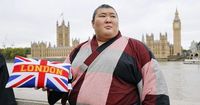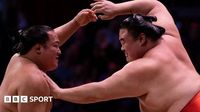Sumo wrestling, the ancient Japanese sport steeped in 1,500 years of tradition, has thundered back into the heart of London, with the Grand Sumo Tournament making a triumphant return to the Royal Albert Hall. For only the second time in history—and the first since 1991—this elite five-day spectacle is being staged outside of Japan, drawing more than 44 of the world’s top rikishi (sumo wrestlers) into the spotlight of one of Britain’s most iconic venues. The event, which began on October 15, 2025, is already captivating fans with its unique blend of ceremony, culture, and sheer athletic might.
Organizers and sumo aficionados alike have hailed this as a landmark occasion, not just for the sport but for cultural exchange. The Royal Albert Hall, famous for hosting everything from classical concerts to rock legends, has been transformed into a sacred arena. At its center sits the dohyo, the revered sumo ring, painstakingly constructed using 11 tons of clay shipped from Japan—a logistical feat that took three months at sea. The ritualized building process, completed on October 13, combined centuries-old tradition with modern engineering, ensuring authenticity down to every last grain of imported earth.
"One of the things that we’ve worked really hard at is to make sure that we have a good understanding of the cultural and religious significance that sumo has," said Matthew Todd, the Royal Albert Hall’s programming director, in an interview with CBS News. "Attention to detail was really critical to the authentic presentation that we’re able to make here." It’s not just the clay that’s been imported—Japanese ring attendants, or yobidashi, have flown in alongside 11 interpreters to help bridge the cultural and linguistic gap with British workers. Above the dohyo, a roof modeled after traditional Shinto shrines hangs suspended, reinforcing the sacred nature of the ring and the rituals that unfold within it.
Before the first bout, a Shinto ring-blessing ceremony set a reverent tone, with hosts James Richardson and Hiro Morita introducing the basic rules and rituals of sumo to an eager crowd. The opening day saw a dazzling Yokozuna rope-tying demonstration, followed by the two current Grand Champions—25-year-old Onosato from Japan and 26-year-old Hoshoryu from Mongolia—performing their majestic ring-entering ceremonies. The crowd, prompted by Morita, shouted "Yoisho!" as the champions stomped the ground to repel evil spirits, a tradition as old as sumo itself.
The spectacle drew thousands of fans—old hands and curious newcomers alike—who filled the auditorium with banners, towels, and raucous cheers. Sumo’s popularity was evident not just inside the hall but across London, as rikishi were spotted posing for selfies at Buckingham Palace, Big Ben, and even riding bikes around the city. The wrestlers, who typically lead highly regimented lives back in Japan—no driving, no breakfast, and mandatory naps after lunch to help them maintain their imposing physiques—were given some rare freedom to enjoy the sights, bringing a touch of sumo’s colorful pageantry to the British capital’s streets.
Back in the ring, the action did not disappoint. The tournament features 100 bouts over five days, with matches showcasing the full spectrum of sumo’s 82 winning techniques, or kimarite. On day one, Tamawashi claimed victory over Wakatakakage in a hard-fought contest, while fan favorites like 33-year-old Ura and 21-year-old Ukrainian sensation Aonishiki drew huge cheers as they entered the ring in their colorful silk kensho-mawashi aprons. The bouts kicked off with some spectacular tsuridashi—frontal lifts out of the ring—drawing gasps and applause from a crowd clearly invested in the drama unfolding before them.
Sumo’s deep ties to Japanese culture and religion were on full display. The sport, which legend holds began as a ritual to ask the gods for a bountiful harvest, has evolved over nearly two millennia into a fiercely competitive discipline. Yet, it still retains its ceremonial heart. The dohyo itself is treated as sacred ground, and every bout is preceded by ritual salt-throwing to purify the ring. The roof suspended above the ring, inspired by Shinto shrines, serves as a constant reminder of the sport’s spiritual roots.
This year’s tournament is notable not just for its setting but for its truly international flavor. While recent champions have hailed from Mongolia, including Hoshoryu, this year’s field also includes two rikishi from Ukraine. Notably absent are American competitors, who have succeeded in past tournaments but are missing from the London lineup. The presence of two yokozuna—Onosato and Hoshoryu—is a rare honor; in nearly 400 years of professional sumo, only 75 men have ever attained this highest rank, which comes with immense prestige and responsibility. Once promoted, a yokozuna retains the title for life, a testament to their skill and character both on and off the dohyo.
To help Western audiences appreciate the nuances of sumo, organizers have provided in-ear English commentary and video replay screens throughout the venue. Sumo’s rules and strategies can be bewildering to the uninitiated, with matches sometimes ending in mere seconds as one wrestler forces the other out of the ring or to the ground. Education and accessibility have been key goals for the event, with hosts and experts working hard to demystify the ancient sport for a new generation of fans.
As the five-day tournament unfolds, anticipation is building toward Sunday’s finale, when the wrestler with the most victories will be crowned champion. The field is wide open, but many in Japan are hoping that Onosato, the country’s first yokozuna in almost a decade, will emerge victorious. For now, the action remains ongoing, with each bout adding another chapter to sumo’s storied history.
For those unable to snag a seat in the Royal Albert Hall, the Grand Sumo Tournament is being broadcast live on BBC iPlayer, the Red Button, and the BBC Sport website and app, ensuring that fans across the UK and beyond can witness this rare and remarkable celebration of Japanese culture and athleticism.
As sumo’s thunderous clashes and intricate rituals continue to echo through the Royal Albert Hall, London finds itself at the center of a unique sporting and cultural exchange. With tradition, technique, and international camaraderie on full display, this Grand Sumo Tournament is shaping up to be an unforgettable event—one that bridges continents and centuries with every stomp and throw on the sacred dohyo.






